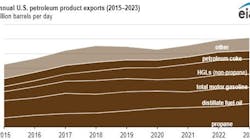Technology advances are expected to increase the economic gas resources base of the US Lower 48 and Canada by 250 tcf and 125 tcf, respectively, according to a new report by the Gas Technology Institute (GTI). The report, titled Natural Gas Supply Sector Summary (GRI-00/0012), outlines several elements that will enable the US and Canada to expand gas supply despite recent market turbulence.
Improved technology is one factor that will enable producers to expand gas resource prospects and reduce costs over the next 15 years, says the Gas Technology Institute. GTI was recently created from the merger of the Gas Research Institute and the Institute of Gas Technology (OGJ Online, June 15, 2000).
Technological advances
Improved geologic knowledge and advances in exploration technology will help find gas-productive areas and plays not yet included in the assessed resource base, says GTI. And new production technology will improve recovery from existing fields. Meanwhile, more-efficient completions will turn formerly uneconomic resources into reserves.
Other supply-enhancing factors include a continued rising in drilling success rates. By 2015, development and exploratory success rates are expected to approach 85% and 30%, respectively, according to the report. Producers will reap these benefits as contributions to their bottom lines.
Declining drilling costs per foot for onshore and offshore in all depth ranges also will aid the expansion. Advanced bits, improved drilling fluids, better rig designs, and greatly improved operating efficiency will contribute to this reduction.
"Technology has been a facilitator to allow producers to develop new gas supply niches," said John Cochener, GTI project manager and principal analyst, resource evaluation. "For example, before the mid-1980s, coalbed methane production was essentially zero. Today, it contributes 1.2 tcf annually to gas production and represents 6.5% of supply.
"The deepwater Gulf of Mexico and Fort Liard region of Canada are two fresh examples of emerging gas supply," Cochener said.
The deepwater gulf play and Canada will form the building blocks for future incremental gas supply. Central and western Gulf of Mexico gas production is projected to increase to more than 8 tcf/year by 2015. And Canadian gas production is projected to grow from 5.8 tcf in 1998 to 7.7 tcf during the same period.
Activity in western Canada is expected to increase substantially, with annual production growing by 1.4 tcf by 2015. And emerging production from offshore eastern Canada is projected to reach 0.6 tcf/year.
"Technology has helped producers survive the 1998 slump and position themselves to produce into today's attractive $4 gas and $30 crude oil price environments," Cochener said.
Deep onshore production (depths greater than 15,000 ft) is projected to increase to 3.5 tcf/year by 2015, representing 19% of onshore production. In particular, deep gas production in the Texas and Louisiana Gulf Coast region is expected to account for about 60% of the projected Lower 48 onshore deep production increase.
Deep gas activity and production is also expected to increase in the Permian basin and Midcontinent US.

